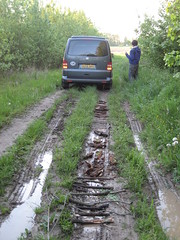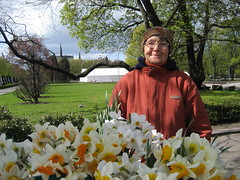Poland with BJ
After our lucky escape from the mud in the Polish ‘Lake District’, we gave up looking for the completely inaccessible lakes and proceeded south down to the capital. Our initial plan was to camp outside the city in the National Park to the west. After half an hour or so of looking, we manoeuvred the van (via a 67 point turn) into a suitable hidden (if a little mosquito ridden) gap in the forest. We had just finished congratulating ourselves on finding such a good location when the National Park warden turned up and politely but very definitely moved us on. So for the second night in a row our wild camping was thwarted – it was so much easier outside Poland. Our trip to the National Park was not wasted, though. Had we not visited we would never have seen the prostitutes lining the side of the road. We couldn’t believe it – there were so many of them. They were not shy about standing right by the side of a busy main road flashing vast amounts of exposed (fake tan encrusted) skin, exposing their bras to the world to display the goods on offer and trying to flag down every car, no matter who it contained (including us).
As we headed into Warsaw, things changed very quickly. After several weeks of seeing almost no tourists and only visiting comparatively small cities / towns in the Baltics, we were suddenly heading back into a built up area and firmly back onto the tourist trail. One bonus of this was that on the way into Warsaw we found a 24 hour Tesco, which we didn’t know existed in Poland, where we thought that we may be able to replace all our emergency food tins (designed for eating in Central Asia when the going gets tough – actually eaten in Norway when the budget got tough). Unfortunately, Polish Tesco might look like Tesco but is actually an imposter and sells exactly the same things as every other Polish supermarket (including fish tanks so that shoppers can pick their own live fish out of the tank with a net – none of that in Watford and slightly off putting watching them all flap around in shopper’s boxes), so it wasn’t as exciting as we had thought.
After some hair-raising navigation on the Warsaw inner ring, we found “Camping 123” just on the outskirts of town. Next day, we were up with the larks (the late ones perhaps) to hop on the tram into the city. Neither of us really knew what to expect of Warsaw given that it was flattened during the war. Our guidebook kicked off with a few gloomy paragraphs about the enormous Soviet Museum of Culture and Art which dominates the west of the city centre. It seems that is it hated by everyone in Warsaw, but we rather liked it – a kind of brooding, Gotham city affair that is only slightly spoiled by a large array of shopping centres and supermarkets below. The rest of central Warsaw was very pleasant – we ambled up the main throughfare (which I insisted on referring to as Nevsky Prospekt as per the main street in St Petersburg, as I do for every main street now – it sounds so much better than “the high street”). We stopped briefly in one of the many Catholic churches to admire the spot where Frederick Chopin’s heart (which was removed from his body and transported back to his native Poland) has been set into a stone pillar. Lovely Then, off to the impressively reconstructed old town which is littered with photos of Warsaw then and now – Roosevelt wandering around war-torn remains contrasting with British stag parties wandering around beer-strewn outside terraces. They have done an amazing job of rebuilding the whole thing and you would never know that almost nothing was left after the war. The day’s activities included, in no particular order, a strange belching water fountain; a compulsory trip on the metro; accidentally walking into a city drugs deal on the outskirts of town; and some horrible pancakes filled with unidentifiable sweet white gunk. We finished our day with a visit to the gorgeous royal parks and lazed around by the ‘Palace on the Water’ whilst the preening peacocks did their best to entertain the admiring crowds.
Our choice form Warsaw was either to visit a series of provincial Polish towns (each complete with the staple Polish ingredients of Old Town, castle and Nazi death camp) or to head to the mountains. So, feeling rather jaded by repeated tales of Soviet occupation in the Baltics and not being quite ready to face the Polish death camps yet, we opted for some fresh air and exercise in the southern resort town of Zacopane in the Tatra mountains. Along the way we beat our previous record for number of prostitutes spotted at the side of the road in an hour. We also saw a decent number of nuns (not at the side of the road with their bras on show, of course) - quite an odd contrast. Once we reached the Tatras, we managed to scale the local mascot mountain of Giewont which was, at 1909m, the highest point of our trip so far. The feeling of success in reaching the top having climbed for a few hours in the heat was slightly diminished by the remarkable number of nuns who also successfully made their way up to the enormous iron cross on the summit – the fact that elderly nuns wearing full habits could make it to the top somehow made it seem like a little jaunt. We also made the rather silly mistake of forgetting to eat anything all day, save a Mars bar and a bag of crisps, which landed us both with a strange exhaustion that lasted most of the way back to Krakow the next day.
Krakow is our final stop in Poland and we have spent most of the last week here – I am writing this on the laptop sat in our campsite before we take BJ back to the airport. We picked the mother-in-law up on Tuesday lunch time, presenting her with a 5 zloty posy of flowers in time honoured East European style. It was lovely to see her and after the standard embraces, hugs, tears and rude comments about Michael’s hair (I’m sure David Beckham never got all this hassle), we headed into town to her hotel. Her hotel room was big enough for a football team and had free internet access, plus a very good shower, so at that point we realised that her trip was doomed because having been in the van for a good while now it is very difficult to turn down the prospect of lounging around on a sofa, drinking coffee / beer, surfing the net and enjoying having a proper shower. After a spot of R&R, we set about exploring the Old Town of Krakow. The city is about to celebrate 750 years, so there was lots going on in addition to the usual sights of Old Town, Castle, Cathedral, lots of nuns and churches, and endless tributes to the local hero, Pope John Paul II, who is featured everywhere.
The highlight of Krakow is the impressive, if rather eclectic, Wawal Castle and Cathedral. We traipsed round some rather dark staterooms ‘admiring’ some rather tired tapestries before heading to the more interesting Cathedral. Here we maintained the tradition of forcing our mothers undertake physical tests by making BJ climb a cramped bell tower for a view over the city (and a view of some enormous bells which everyone seemed to want to touch to bring them good luck). This was all done with the company of an incredible number of school groups – May is clearly the time when the Polish syllabus dictates that twelve year old children must visit Krakow in large groups, wearing identically coloured caps and get in everyone’s way.
Barbara became the third member of RTW2007 for the day when we drove in the van out to Oswiecim (or Auschwitz in German) to look around the Nazi concentration camps. This was a sombre affair, but very interesting and in beautiful weather. We went to both the main Auschwitz camp and also to the Birkenau camp, which is subtitled Auschwitz II, and which is even more striking. Birkenau is less of a museum than Auschwitz and has more of the original camp, barracks, watch towers and railway than Auschwitz itself. Eerily, most of the barracks were destroyed deliberately by fire, started by the retreating Nazi’s when they tried to hide their tracks as the Soviets (this time they were being the goodies) approached - all that now remains are rows and rows of brick chimneys that stand alone, marking the spaces where the blocks housing hundreds of prisoners used to stand.
We spent our final day with Barbara wandering more of the Old Town and taking a very amusing ride in a horse drawn stately carriage around town – waving regally to the proletariat. The proletariat included a large number of English stag dos; some girls advertising Linx who were parading around town in tiny police uniforms (much to the delight of the stags); and huge numbers of police (presumably also stag related). We joined in by going for a few pints and a curry, so now I’m here in the sunshine with a hangover, planning the next few days.
The weather had taken a real turn and most of the week we have been sweltering in 32 degree heat. It was strange too be able to sit around the campsite with Barbara in the sunshine on the camping chairs that we nearly didn’t bring, contemplating being back in Estonia only a short while ago when even to open the van door was a punishable offence due to the cold.
We have some busy travelling days ahead now. We start a jaunt into Western Europe, which is only a quick speed through designed solely to get to Munich so that we can pick up our Carnet de Passages and get the van serviced. I would like to say I booked a van service over the phone with Munich in my impeccable Year 10 German but it’s just not true, they all spoke perfect English. Then it back through Austria to Budapest where we need to try and organise our Chinese visas. In a week’s time we will be heading onwards to Romania and the Ukraine.
Hello to BJ once you read this back at home – it was really lovely having you with us for a few days…. roll on India! Also hello to our readers in Silkstone – we were impressed to hear how many people have been reading this from Silkstone, including the ladies at Silkstone Post Office!!








